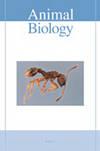水疱甲虫对植物挥发物的电生理和行为反应
IF 0.9
4区 生物学
Q2 ZOOLOGY
引用次数: 0
摘要
植物挥发物,包括组成性挥发物和诱导性挥发物,被害虫感知以确定寄主植物的位置,也被天敌感知以确定寄主昆虫的位置。这些植物挥发物可用于开发有吸引力或驱避的害虫管理诱饵。对鸽豆、Cajanus cajan (L.)的植物挥发物进行了鉴定。胡特是由于草食水疱甲虫(Mylabris pustulata)。采用动态顶空收集法,以80-100目的Porapaq Q为吸附剂,对健康的无病鸽豆植株和有病的水蚤植株进行挥发物的收集。采用气相色谱-质谱联用技术,从未侵染的鸽子豌豆中鉴定出28种化合物,从侵染的鸽子豌豆中鉴定出16种化合物。定性分析表明,侵染植株中只检测到α-蒎烯和3-己烯-2-酮,侵染植株释放的(Z)-3-己烯-1-乙酸酯和苯乙酮的量高于未侵染植株。对这些挥发物和其他植物挥发物的电生理评价表明,水疱甲虫的触角对1 μg剂量的桉树酚、10 μg剂量的橙花酚以及100和1000 μg剂量的乙酸苄引起更高的反应。桉树醇、苯甲醛、乙酸苄酯和橙花醇引诱的成虫数量很少,提示有必要进一步规范引诱物和引诱器的设计。本文章由计算机程序翻译,如有差异,请以英文原文为准。
Electrophysiological and behavioral responses of blister beetle Mylabris pustulata to plant volatiles
Plant volatiles, constitutive or induced, are perceived by insect pests to locate the host plant and also by natural enemies to locate the host insect. These plant volatiles can be utilized to develop attractive or repellant lures for pest management. Studies were carried out to identify the plant volatiles which are induced in pigeonpea, Cajanus cajan (L.) Huth due to the herbivory of blister beetle, Mylabris pustulata. The volatiles from healthy uninfested pigeonpea plants and blister beetle-infested plants were collected using the dynamic headspace collection method with Porapaq Q (80-100 mesh) as adsorbent. Using gas chromatography-mass spectrometry, 28 compounds were identified from uninfested pigeonpea plants whereas 16 compounds were identified from infested plants. A qualitative analysis showed that α-pinene and 3-hexen-2-one were exclusively detected in infested plants and (Z)-3-hexen-1-yl acetate and acetophenone were released in higher quantities from infested plants than from uninfested one. Electrophysiological evaluation of these volatiles along with other plant volatiles showed that blister beetle antennae eliciting higher responses to eucalyptol at a 1-μg dose, to nerol at a 10-μg dose and to benzyl acetate at 100- and 1000-μg doses. Beetle traps with lures of eucalyptol, benzaldehyde, benzyl acetate, and nerol attracted a very small number of blister beetle adults, suggesting the need for further efforts to standardize lure load and trap design.
求助全文
通过发布文献求助,成功后即可免费获取论文全文。
去求助
来源期刊

Animal Biology
生物-动物学
CiteScore
2.10
自引率
0.00%
发文量
34
审稿时长
3 months
期刊介绍:
Animal Biology publishes high quality papers and focuses on integration of the various disciplines within the broad field of zoology. These disciplines include behaviour, developmental biology, ecology, endocrinology, evolutionary biology, genomics, morphology, neurobiology, physiology, systematics and theoretical biology. Purely descriptive papers will not be considered for publication.
Animal Biology is the official journal of the Royal Dutch Zoological Society since its foundation in 1872. The journal was initially called Archives Néerlandaises de Zoologie, which was changed in 1952 to Netherlands Journal of Zoology, the current name was established in 2003.
 求助内容:
求助内容: 应助结果提醒方式:
应助结果提醒方式:


